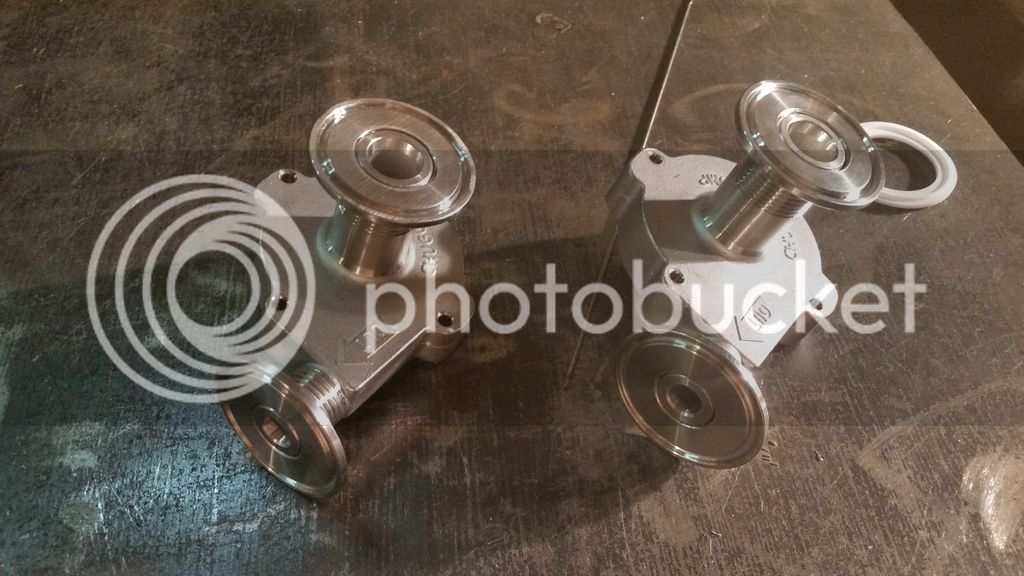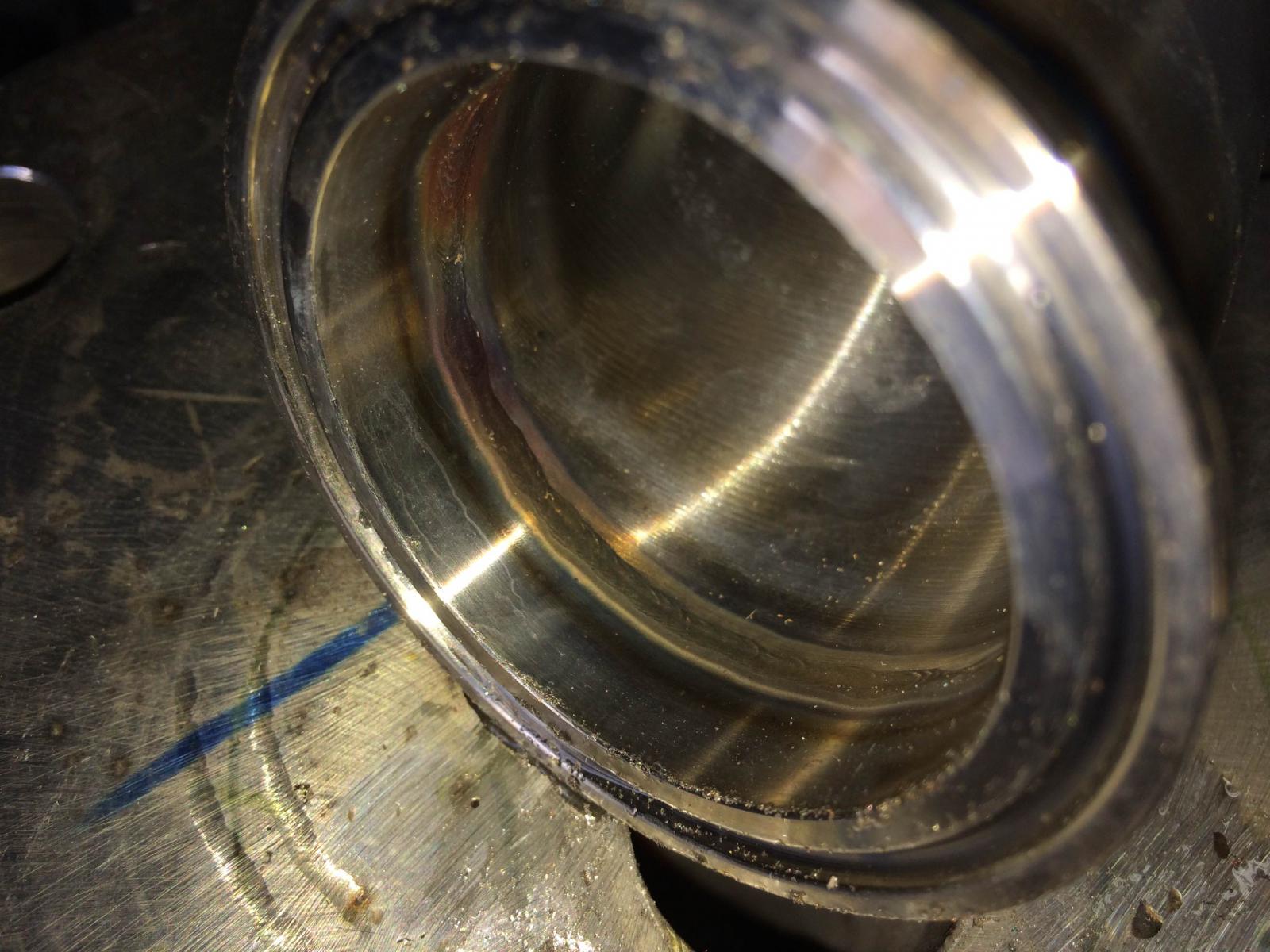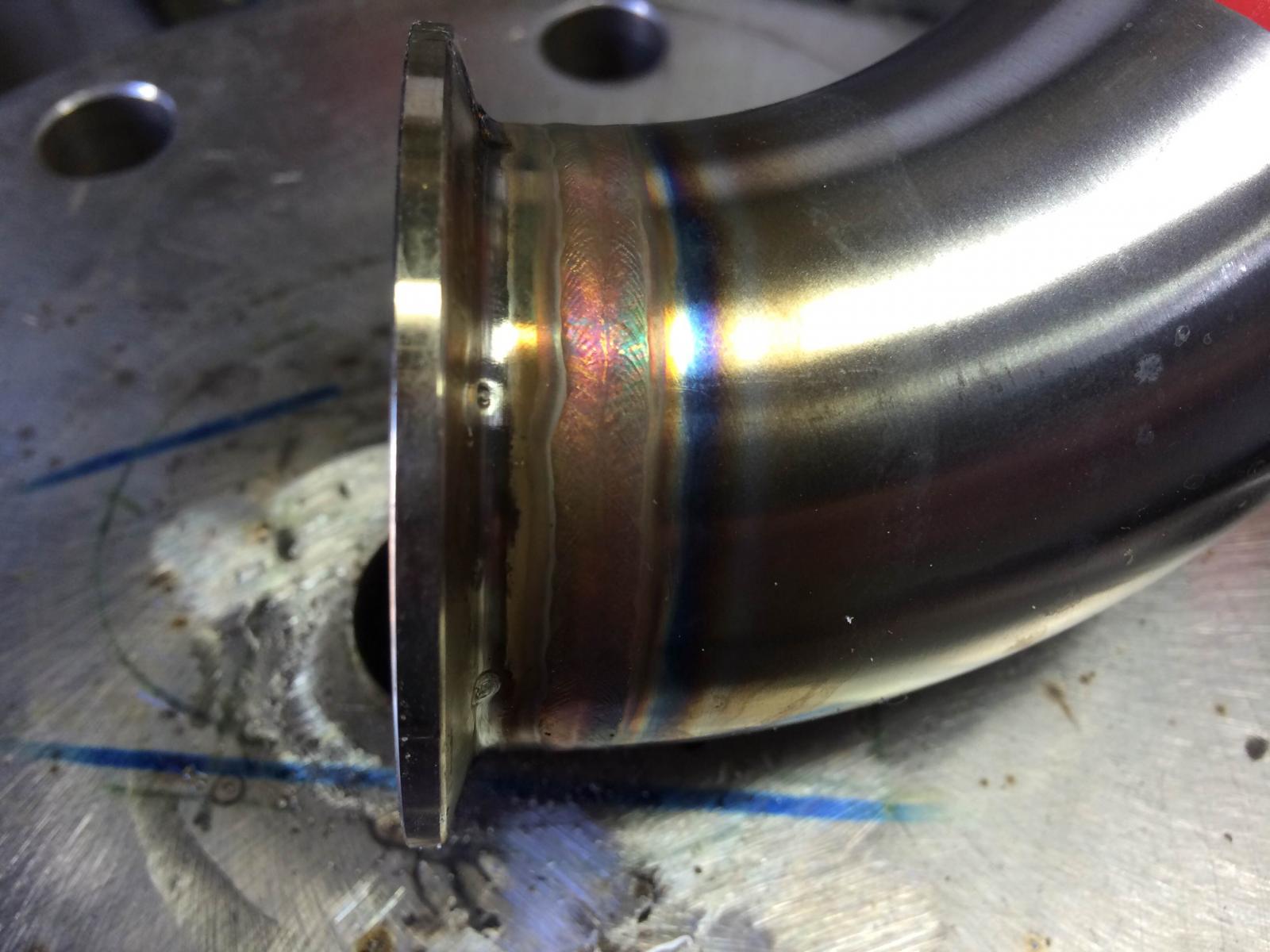You are using an out of date browser. It may not display this or other websites correctly.
You should upgrade or use an alternative browser.
You should upgrade or use an alternative browser.
Tig welding!!
- Thread starter 1fast636
- Start date

Help Support Homebrew Talk:
This site may earn a commission from merchant affiliate
links, including eBay, Amazon, and others.
Digitizer101
Active Member
So I just want to say I love to look at good welds. I get very Jealous but still love to look. If you are feeling down about your welds just stop and watch one of my videos of my brew stand build and you will feel much, much, better.
https://www.youtube.com/playlist?list=PLA5YysQeKcY3Vp6mhZacqFduBSkRv4Mwe
And please don't laugh out loud.
Enjoy
https://www.youtube.com/playlist?list=PLA5YysQeKcY3Vp6mhZacqFduBSkRv4Mwe
And please don't laugh out loud.
Enjoy
1fast636
Well-Known Member
Second time welding with 535 filler did a hot no filler pass on both sides then welded with filler
View attachment ImageUploadedByHome Brew1432323651.622054.jpg
View attachment ImageUploadedByHome Brew1432323686.338435.jpg
View attachment ImageUploadedByHome Brew1432323698.761005.jpg
View attachment ImageUploadedByHome Brew1432323651.622054.jpg
View attachment ImageUploadedByHome Brew1432323686.338435.jpg
View attachment ImageUploadedByHome Brew1432323698.761005.jpg
View attachment 279771/QUOTE]
I see a lot of those crater pits created when you stop the weld. I saw a trick on YouTube where they used the down slop of 1-2 seconds to prevent that. Just keep the torch moving when you cut the power. It works great.
1fast636
Well-Known Member
Interesting will give it a try on Tuesday, and that material was horrible for tig welding in the first place and nothing I did would clean up the grease soaked material I hit it with a grinder for ten mins good crazy cleaner and still had this grease film deal on it I wish it didn't have those blemishes threw it would make the smurf blood look so much better
1fast636
Well-Known Member
Stainless job finally
View attachment ImageUploadedByHome Brew1433379893.703778.jpg
View attachment ImageUploadedByHome Brew1433379960.854496.jpg
View attachment ImageUploadedByHome Brew1433379995.654116.jpg
View attachment ImageUploadedByHome Brew1433380036.339936.jpg
View attachment ImageUploadedByHome Brew1433380063.604134.jpg
View attachment ImageUploadedByHome Brew1433379893.703778.jpg
View attachment ImageUploadedByHome Brew1433379960.854496.jpg
View attachment ImageUploadedByHome Brew1433379995.654116.jpg
View attachment ImageUploadedByHome Brew1433380036.339936.jpg
View attachment ImageUploadedByHome Brew1433380063.604134.jpg

$33.99 ($17.00 / Count)
$41.99 ($21.00 / Count)
2 Pack 1 Gallon Large Fermentation Jars with 3 Airlocks and 2 SCREW Lids(100% Airtight Heavy Duty Lid w Silicone) - Wide Mouth Glass Jars w Scale Mark - Pickle Jars for Sauerkraut, Sourdough Starter
Qianfenie Direct

$479.00
$559.00
EdgeStar KC1000SS Craft Brew Kegerator for 1/6 Barrel and Cornelius Kegs
Amazon.com

$7.79 ($7.79 / Count)
Craft A Brew - LalBrew Voss™ - Kveik Ale Yeast - For Craft Lagers - Ingredients for Home Brewing - Beer Making Supplies - (1 Pack)
Craft a Brew
![Craft A Brew - Safale S-04 Dry Yeast - Fermentis - English Ale Dry Yeast - For English and American Ales and Hard Apple Ciders - Ingredients for Home Brewing - Beer Making Supplies - [1 Pack]](https://m.media-amazon.com/images/I/41fVGNh6JfL._SL500_.jpg)
$6.95 ($17.38 / Ounce)
$7.47 ($18.68 / Ounce)
Craft A Brew - Safale S-04 Dry Yeast - Fermentis - English Ale Dry Yeast - For English and American Ales and Hard Apple Ciders - Ingredients for Home Brewing - Beer Making Supplies - [1 Pack]
Hobby Homebrew

$20.94
$29.99
The Brew Your Own Big Book of Clone Recipes: Featuring 300 Homebrew Recipes from Your Favorite Breweries
Amazon.com

$53.24
1pc Hose Barb/MFL 1.5" Tri Clamp to Ball Lock Post Liquid Gas Homebrew Kegging Fermentation Parts Brewer Hardware SUS304(Liquid Hose Barb)
yunchengshiyanhuqucuichendianzishangwuyouxiangongsi

$22.00 ($623.23 / Ounce)
AMZLMPKNTW Ball Lock Sample Faucet 30cm Reinforced Silicone Hose Secondary Fermentation Homebrew Kegging joyful
无为中南商贸有限公司

$76.92 ($2,179.04 / Ounce)
Brewing accessories 1.5" Tri Clamp to Ball Lock Post Liquid Gas Homebrew Kegging Fermentation Parts Brewer Hardware SUS304 Brewing accessories(Gas Hose Barb)
chuhanhandianzishangwu

$176.97
1pc Commercial Keg Manifold 2" Tri Clamp,Ball Lock Tapping Head,Pressure Gauge/Adjustable PRV for Kegging,Fermentation Control
hanhanbaihuoxiaoshoudian

$58.16
HUIZHUGS Brewing Equipment Keg Ball Lock Faucet 30cm Reinforced Silicone Hose Secondary Fermentation Homebrew Kegging Brewing Equipment
xiangshuizhenzhanglingfengshop

$44.99
$49.95
Craft A Brew - Mead Making Kit – Reusable Make Your Own Mead Kit – Yields 1 Gallon of Mead
Craft a Brew

$719.00
$799.00
EdgeStar KC2000TWIN Full Size Dual Tap Kegerator & Draft Beer Dispenser - Black
Amazon.com

$159.50 ($26.58 / Count)
3M High Flow Series System BREW120-MS, 5616001, For Brewed Coffee and Hot Tea, Valve-in-Head Design
Amazon.com

$53.24
1pc Hose Barb/MFL 1.5" Tri Clamp to Ball Lock Post Liquid Gas Homebrew Kegging Fermentation Parts Brewer Hardware SUS304(Liquid Hose Barb)
Guangshui Weilu You Trading Co., Ltd

$10.99 ($31.16 / Ounce)
Hornindal Kveik Yeast for Homebrewing - Mead, Cider, Wine, Beer - 10g Packet - Saccharomyces Cerevisiae - Sold by Shadowhive.com
Shadowhive
sandyeggoxj
Well-Known Member
1fast636
Well-Known Member
That's awesome because the crazy thing is I was just thinking about this today while doing some side work after welding, and my stainless hop spider I will have pics of in the next week or two,
More ss work today
View attachment ImageUploadedByHome Brew1433470348.412862.jpg
View attachment ImageUploadedByHome Brew1433470382.660751.jpg
Tried some actual walking the cup I need to work on that lol
View attachment ImageUploadedByHome Brew1433470473.906956.jpg
More ss work today
View attachment ImageUploadedByHome Brew1433470348.412862.jpg
View attachment ImageUploadedByHome Brew1433470382.660751.jpg
Tried some actual walking the cup I need to work on that lol
View attachment ImageUploadedByHome Brew1433470473.906956.jpg
sandyeggoxj
Well-Known Member
I got the idea from chuggers website. I read it and immediately said "well duh"! Haha. My neighbor has a machine shop in his garage. So that helps...
I got the idea from chuggers website. I read it and immediately said "well duh"! Haha. My neighbor has a machine shop in his garage. So that helps...
I'm also planning on doing this as well. What TIG settings did you use?
sandyeggoxj
Well-Known Member
I'm also planning on doing this as well. What TIG settings did you use?
Started with a double beveled edge. About 70 amps. .040 308l rod and 1/16 tungsten. 15 cfh. Full pedal until it warmed up nice and then backed off a little bit.
1fast636
Well-Known Member
Did you back gas or purg anything If not this is something I can actually do no problem at work I'm still figuring out how to get some sanitary/purg set up made to have my keggles perfect when I get them
sandyeggoxj
Well-Known Member
I didnt. Everything is so thick I wasn't burning through the back. I did use a gas lens. But I use that for all my stainless.
Shortyz question on purging, any easy purge set ups we don't have anything to do purging which I hate, and any tips when welding with a purge set up? I have seen a tube from an extra bottle running into capped ends with alum foil does that work?
Ok I am back. i will hit a few questions with mutiple topics but here we go.
To purge properly, you need dual regs on your bottle. this allows you to set the CFM to the proper setting depending on what you are welding, big pipe requires big cfm. Remember when purging you should always have your gas feed at the lowest point because argon is heavier then air and you want it to displace the air not mix with it (the result is popcorn, or in technical terms chromium carbide precipitates, they are really tough to grind out). I work with .065 pipe alot so im using like 20cfm @ 57-59 amps. the pictures below are of the dual regs and turntable i use, along with some purge fittings. Foil tape works fine for plugging an open purge end, just poke 4 holes in it and your good to go. I use pipe plug inserts because it speeds things up a bit.
Torch setup is vital to a good weld aswell, i use the LARGE gas lense with a 10 cup, this baby gives you huge gas coverage. A gas lense is a must!
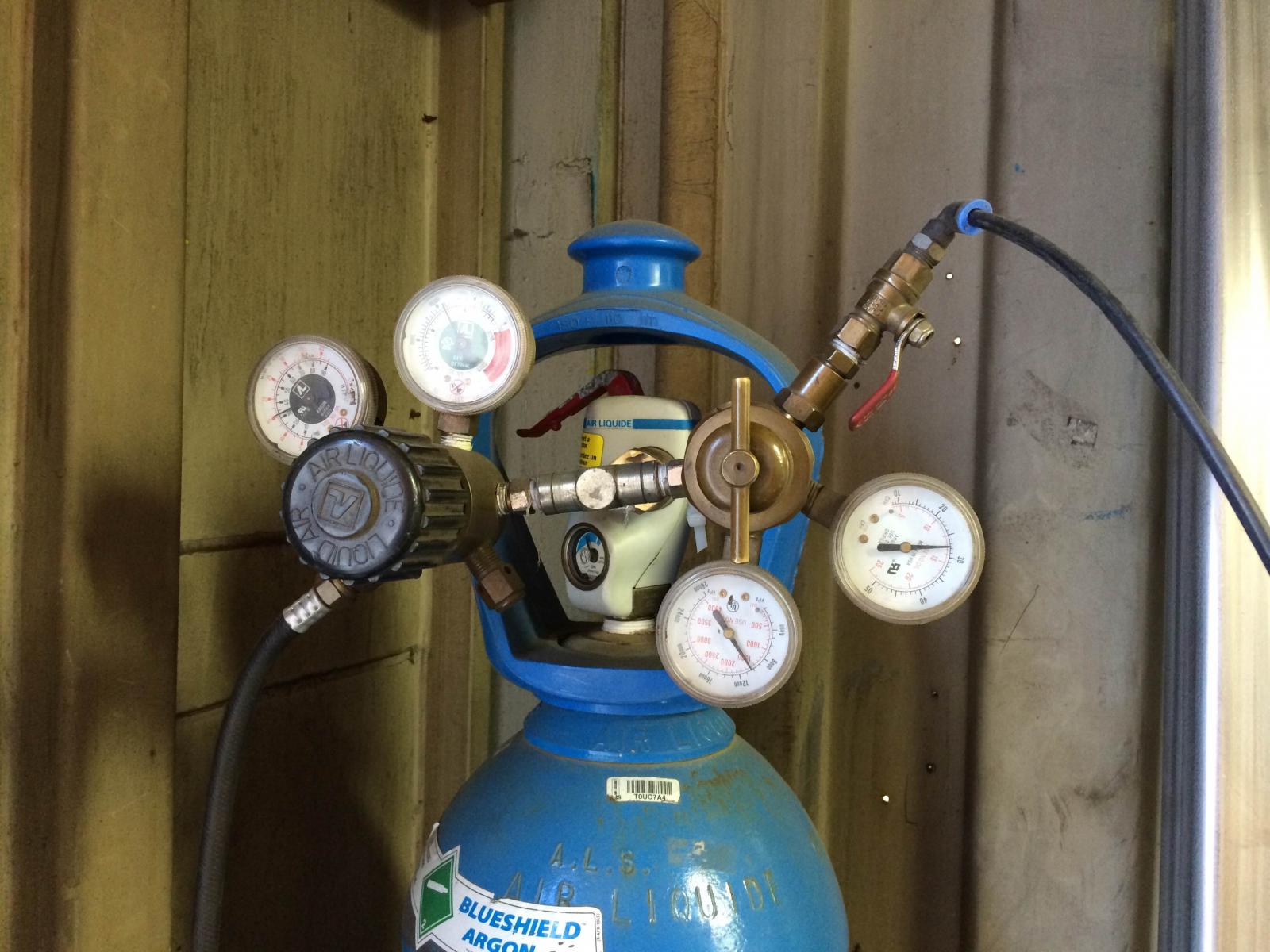
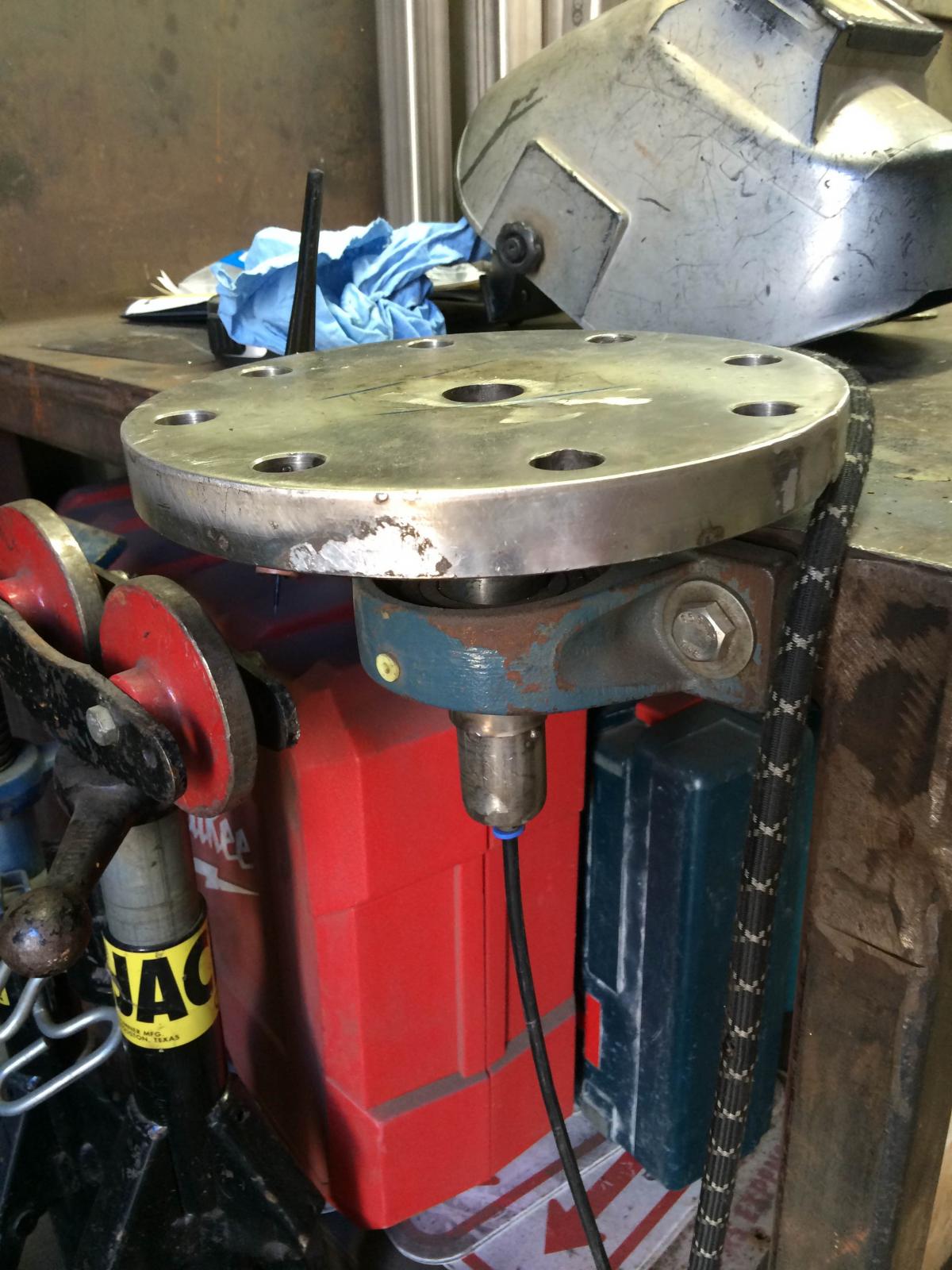
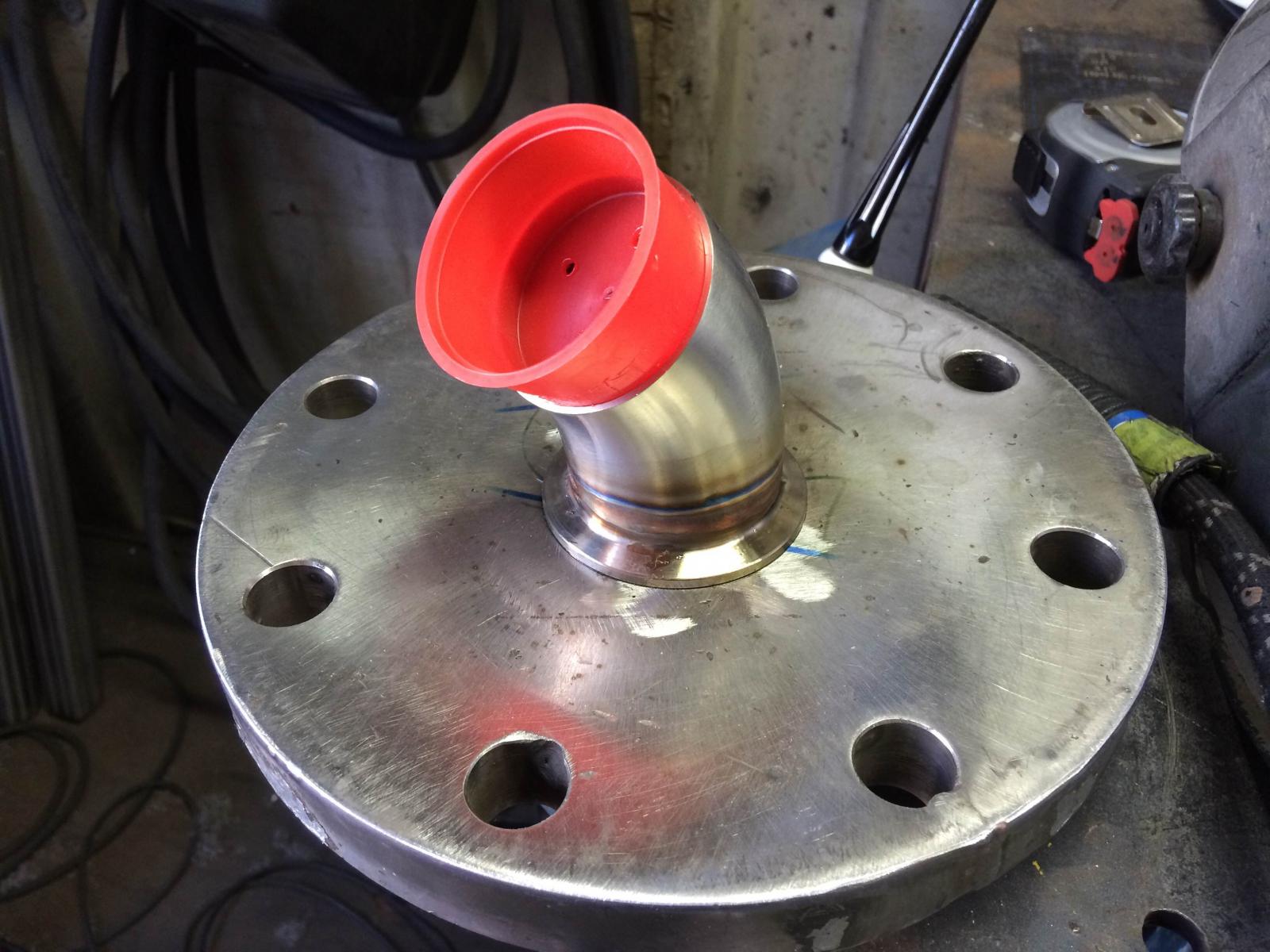
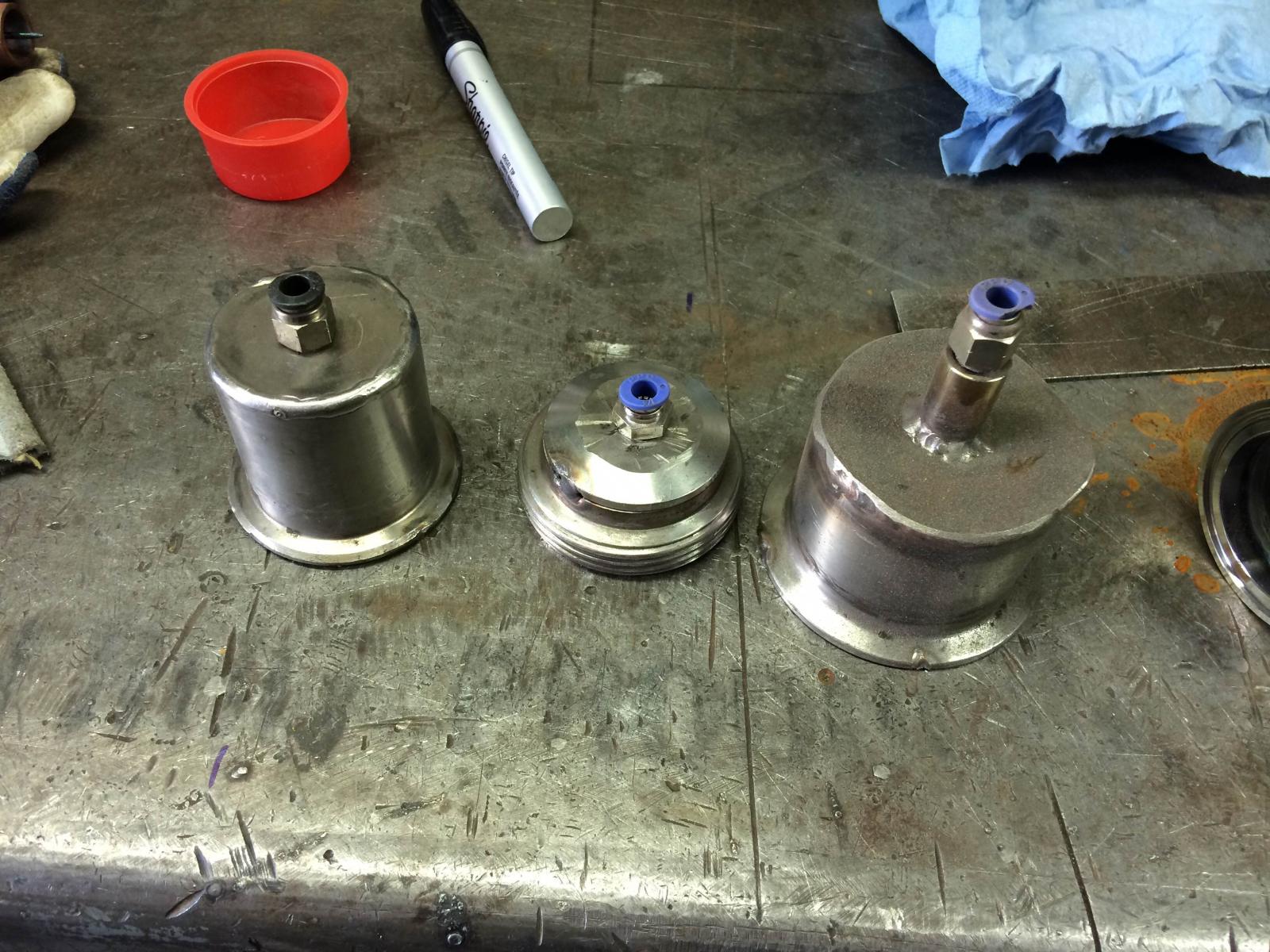
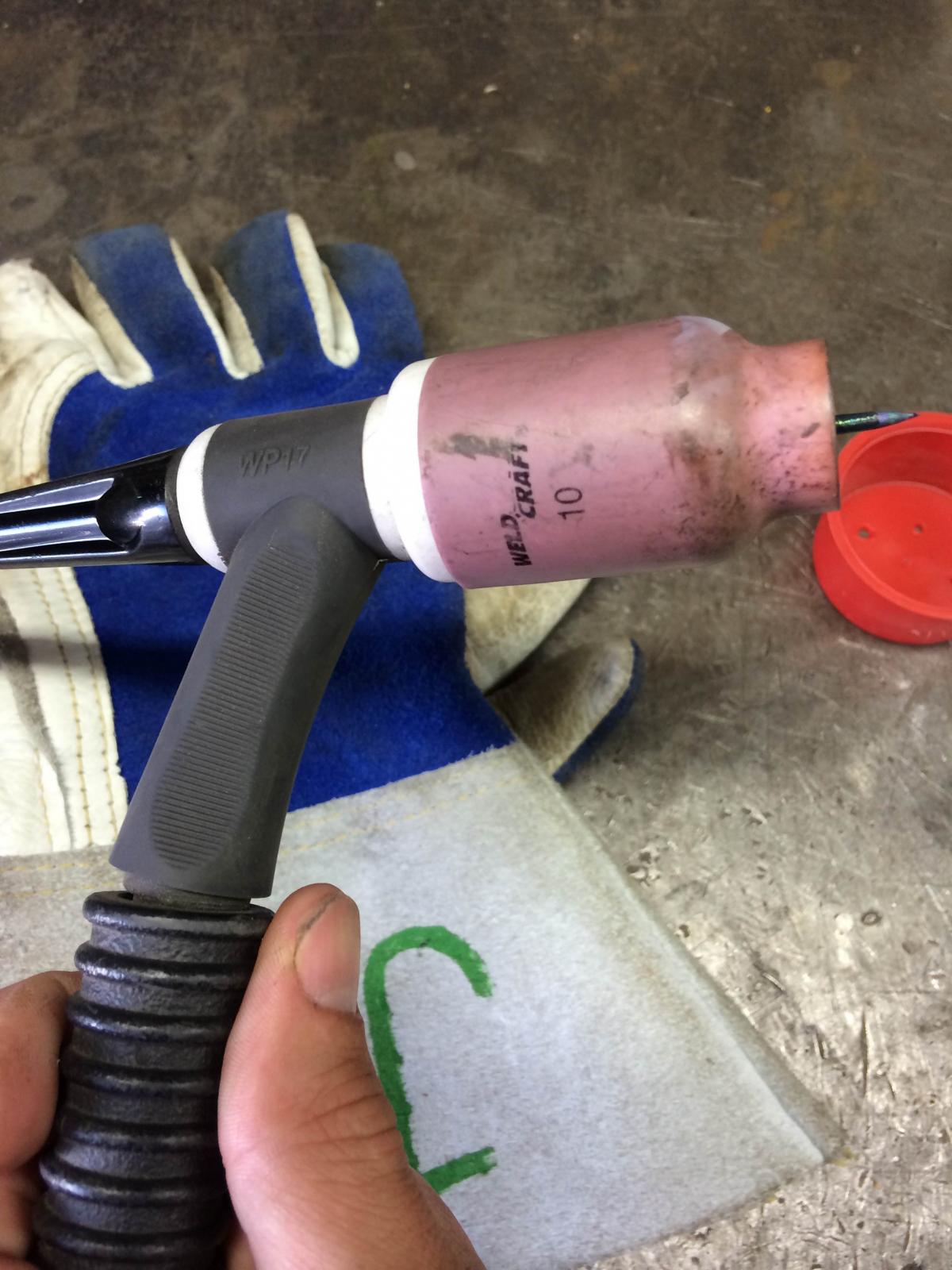
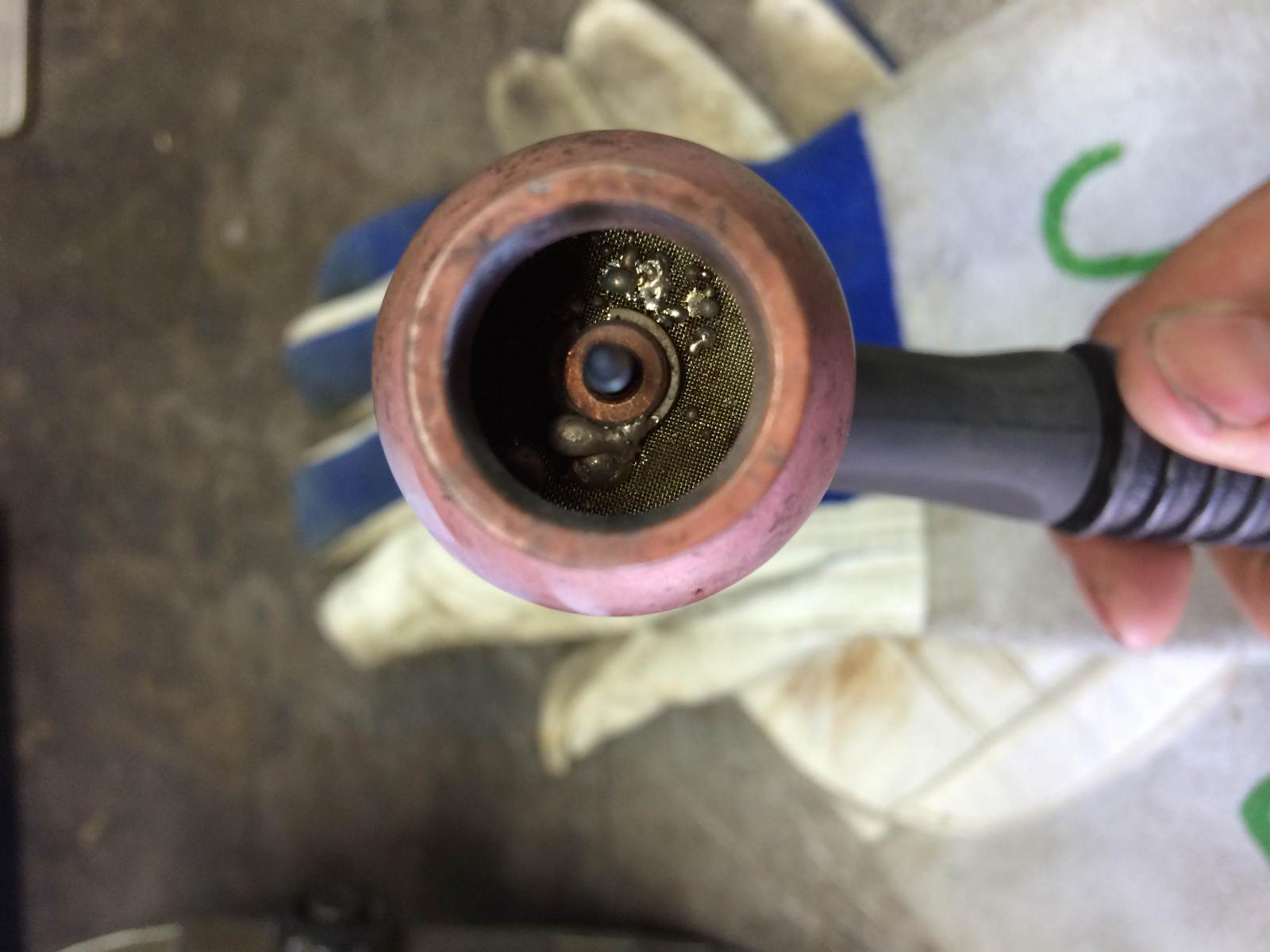
Perfect!
I am wondering the best way to weld a back to back triclamp fitting inside the keggle. Basically 1 1.5" tri clamp on the outside connected to another 1.5" on the inside to run recirculation through a herms coil.
Also, any tips for purging a 50' coil to a tri-clamp fitting as well as the flow rates needed for purging.
For the back to back ferrule fitting i would buy 2 "long 1" ferrule" (clamp size is the same on 1" and 1.5" and i doubt your coil is 1.5"). Heres what i would do, grab a 1" hole saw, drill your 1/4" pilot hole first before setting the hole saw on the arbor, because you will break the bit when you break through
first picture is how we backpurge to weld fitting into tanks without contaminated the weld (2 guys needed, communication is key to proper penetration)
second picture is the backpurge fitting, now look closely. You can see the same gas lense idea with the purge fittings. ALWAYS stuff some steel wool or scrubby pad in the purge fittings. This creates laminar flow, if you dont know what that is go youtube it.
keep the questions coming in, if you dont understand my drivel ask me to clarify with pictures or something. cheers!
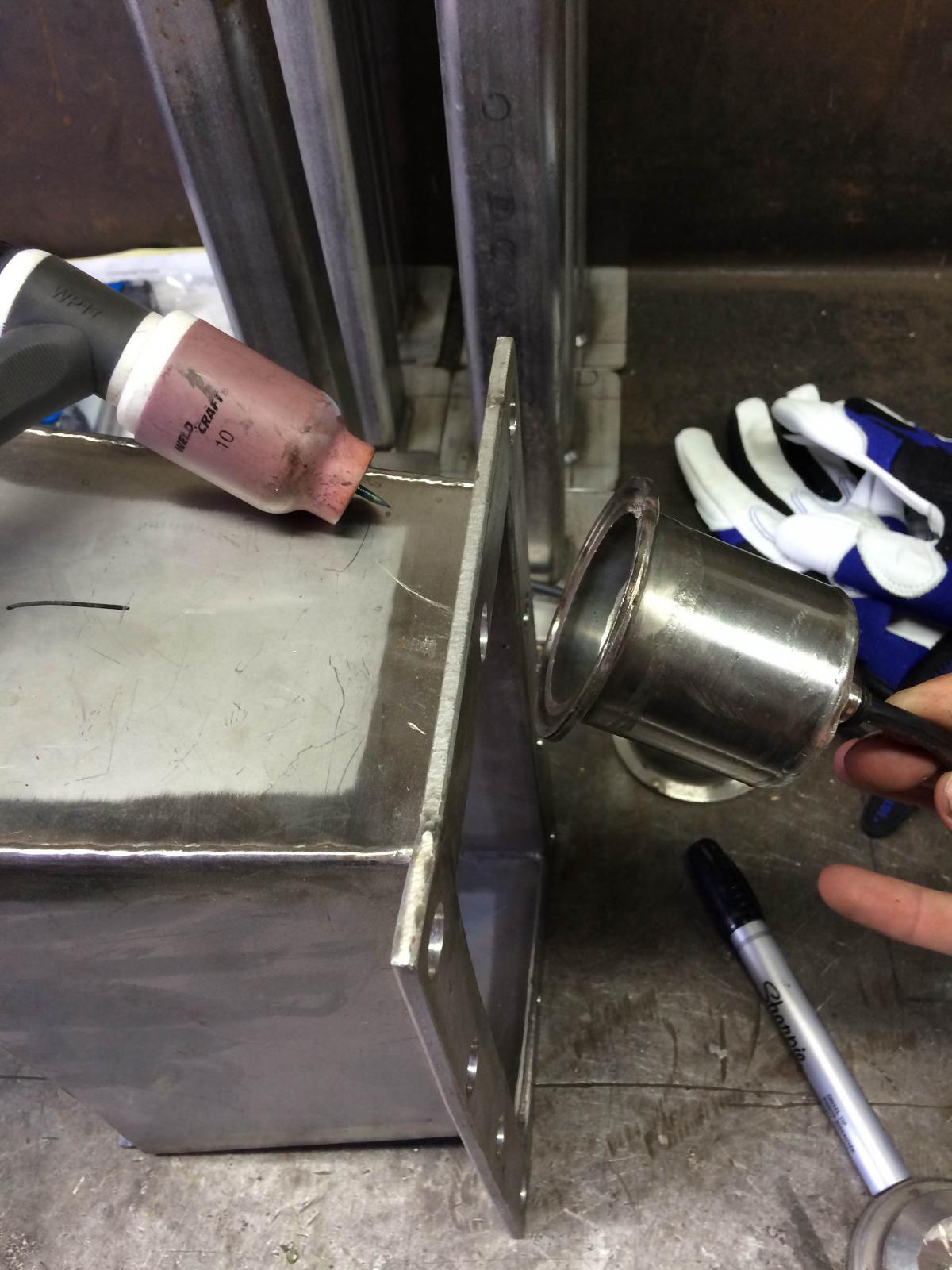
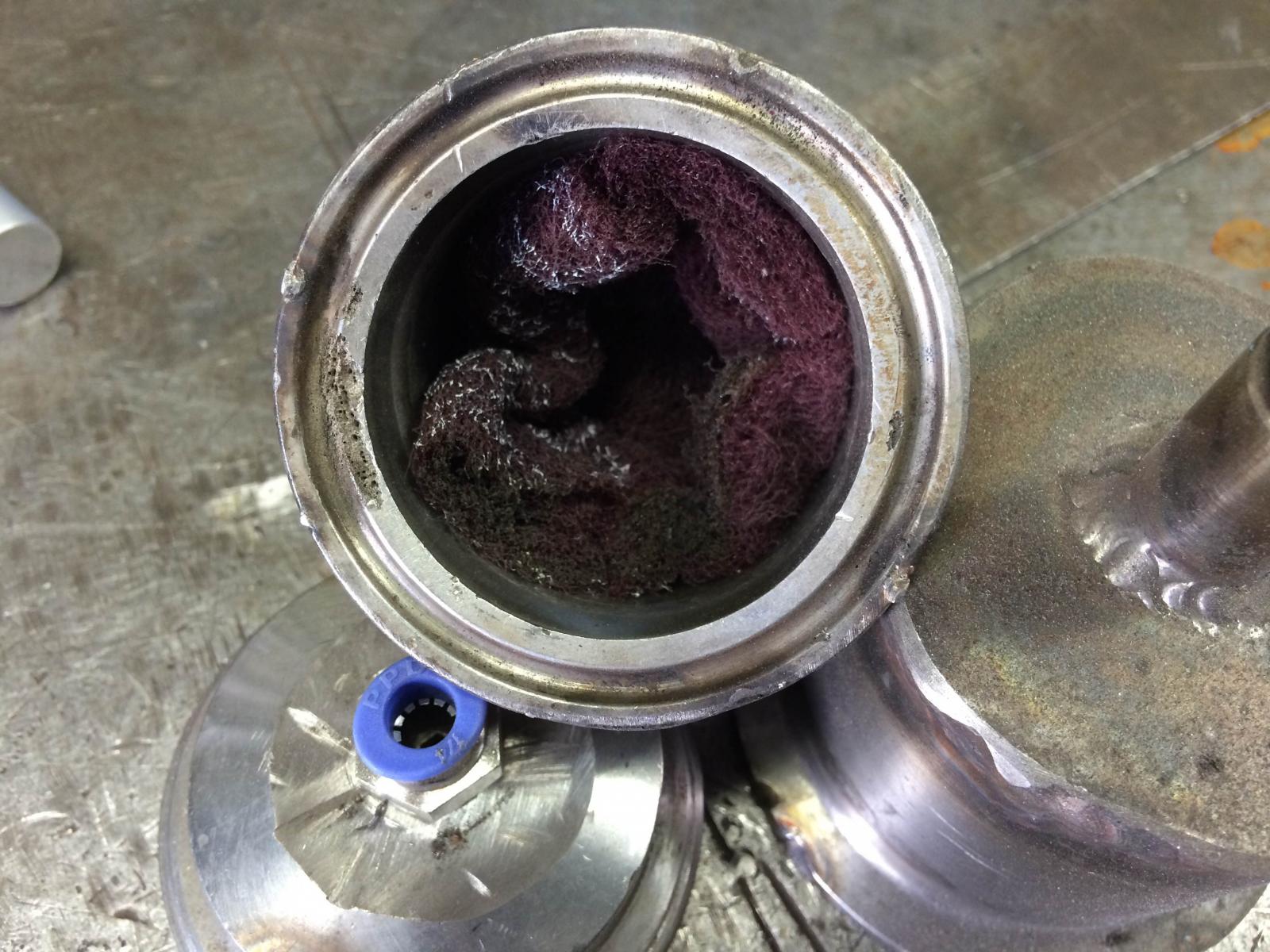
Also guys, just remember a weld may look really nice (like some guy walking the cup at 40 amps) but the weld is garbage and the penetration is piss poor. I see this time and time again, it aint on the surface that what counts. stack all the dimes you want but if that weld isnt done at the proper amperage for the material thickness it will fail.
ex: if i am welding 1/4" structural SS i will do a root pass at 180 amps and cap it at 140.
ex: if i am welding 1/4" structural SS i will do a root pass at 180 amps and cap it at 140.
Purge setup on a 2" pipe. Masking tape works to plug off the end aswell..
I always use 3/32 tungsten, never change for any jobs. Was using 2% thoriated but thats cancerous so i switch to lanthanated and never looked back.
only filler i carry is 1/8" and 5/32.
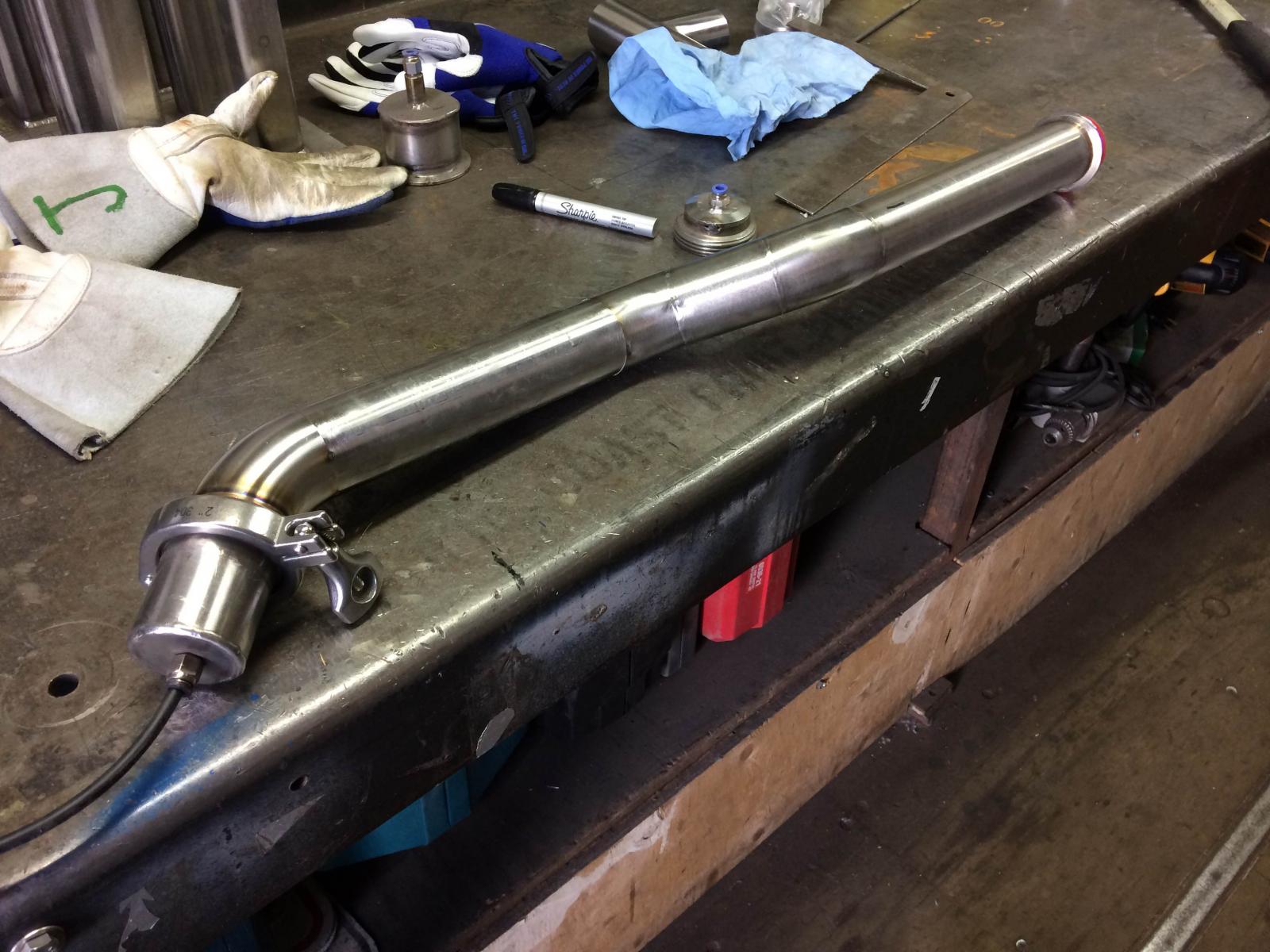
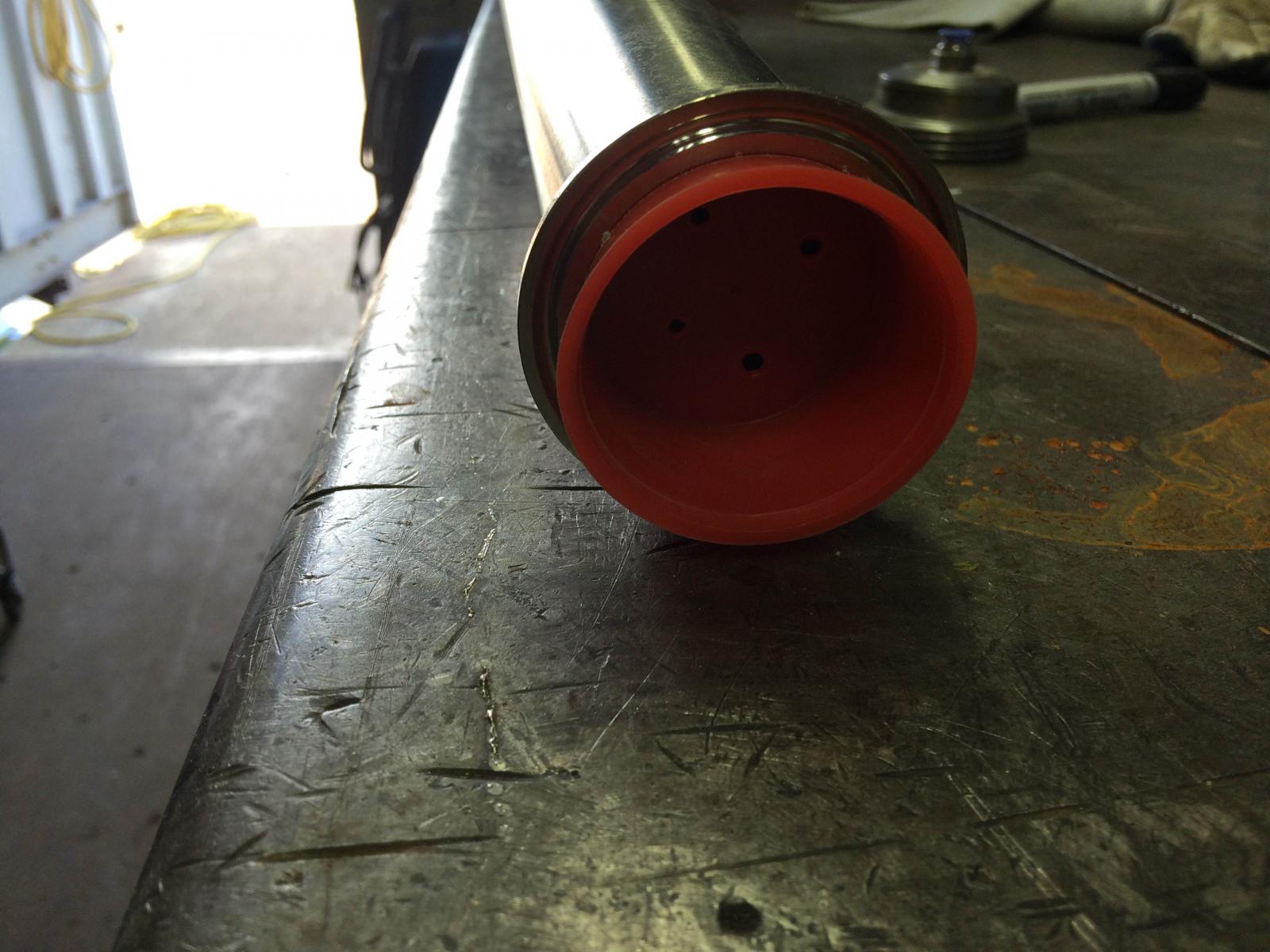
I always use 3/32 tungsten, never change for any jobs. Was using 2% thoriated but thats cancerous so i switch to lanthanated and never looked back.
only filler i carry is 1/8" and 5/32.


Also guys, just remember a weld may look really nice (like some guy walking the cup at 40 amps) but the weld is garbage and the penetration is piss poor. I see this time and time again, it aint on the surface that what counts. stack all the dimes you want but if that weld isnt done at the proper amperage for the material thickness it will fail.
ex: if i am welding 1/4" structural SS i will do a root pass at 180 amps and cap it at 140.
I don't TIG, but this is true for any and all welding. I've seen pretty welds fail.
1fast636
Well-Known Member
Two action shots got to edit the video and condenses it alil taking to long to load lol
View attachment ImageUploadedByHome Brew1434688533.777332.jpg
View attachment ImageUploadedByHome Brew1434688559.403665.jpg
And to finish the day I kegged two beers
View attachment ImageUploadedByHome Brew1434688593.240883.jpg
View attachment ImageUploadedByHome Brew1434688533.777332.jpg
View attachment ImageUploadedByHome Brew1434688559.403665.jpg
And to finish the day I kegged two beers
View attachment ImageUploadedByHome Brew1434688593.240883.jpg
1fast636
Well-Known Member
Fusion no filler
View attachment ImageUploadedByHome Brew1441237936.270468.jpg
Some mild steel work
View attachment ImageUploadedByHome Brew1441238287.679155.jpg
Some build up work on a axle shaft working on my weave work
View attachment ImageUploadedByHome Brew1441238362.866710.jpg
View attachment ImageUploadedByHome Brew1441237936.270468.jpg
Some mild steel work
View attachment ImageUploadedByHome Brew1441238287.679155.jpg
Some build up work on a axle shaft working on my weave work
View attachment ImageUploadedByHome Brew1441238362.866710.jpg
hugenjapan
Well-Known Member
- Joined
- Mar 14, 2013
- Messages
- 114
- Reaction score
- 10
hugenjapan
Well-Known Member
- Joined
- Mar 14, 2013
- Messages
- 114
- Reaction score
- 10
Lol
hugenjapan
Well-Known Member
- Joined
- Mar 14, 2013
- Messages
- 114
- Reaction score
- 10
What's wrong with it?
What's wrong with it?
I think he's talking about the OP.
1fast636
Well-Known Member
Made a purge set up finally and got to play around with this today full purge, fusion weld nice and clean on the insides now time for more research and to get them perfect so I can weld on my keg fittings
View attachment ImageUploadedByHome Brew1441313574.950214.jpg
View attachment ImageUploadedByHome Brew1441313600.458503.jpg
View attachment ImageUploadedByHome Brew1441313619.249536.jpg
Next item in store is to make a turn table I know I'm not the greatest tug welder but I'm only 6 months in and have come along way
View attachment ImageUploadedByHome Brew1441313574.950214.jpg
View attachment ImageUploadedByHome Brew1441313600.458503.jpg
View attachment ImageUploadedByHome Brew1441313619.249536.jpg
Next item in store is to make a turn table I know I'm not the greatest tug welder but I'm only 6 months in and have come along way
1fast636
Well-Known Member
Another practice run with purge
View attachment ImageUploadedByHome Brew1441418435.177554.jpg
View attachment ImageUploadedByHome Brew1441418456.020813.jpg
Now my question to the experts how do you get the nice bead on the inside with purge welding? Do I need to up my amps, I did this run at 45A pushing 7 thru the purge set up
View attachment ImageUploadedByHome Brew1441418435.177554.jpg
View attachment ImageUploadedByHome Brew1441418456.020813.jpg
Now my question to the experts how do you get the nice bead on the inside with purge welding? Do I need to up my amps, I did this run at 45A pushing 7 thru the purge set up
sandyeggoxj
Well-Known Member
I am NOT a pro at all. But from my playing around and from what I have read is that you get it all purging like normal and then form a puddle and sit on it long enough until it just barely starts to fall in. And then keep moving where the puddle is right on the edge of falling in as you move. That should get you complete fusion.
What is the wall thickness? Inverter or transformer machine? I usually start with the basic start of 1 amp per 0.001" wall plus a couple amps and then use the pedal to dial it in at the end. It also helps to ease off on the pedal at the end to keep it smooth and minimize the crater.
What is the wall thickness? Inverter or transformer machine? I usually start with the basic start of 1 amp per 0.001" wall plus a couple amps and then use the pedal to dial it in at the end. It also helps to ease off on the pedal at the end to keep it smooth and minimize the crater.
Similar threads
- Replies
- 4
- Views
- 2K











































